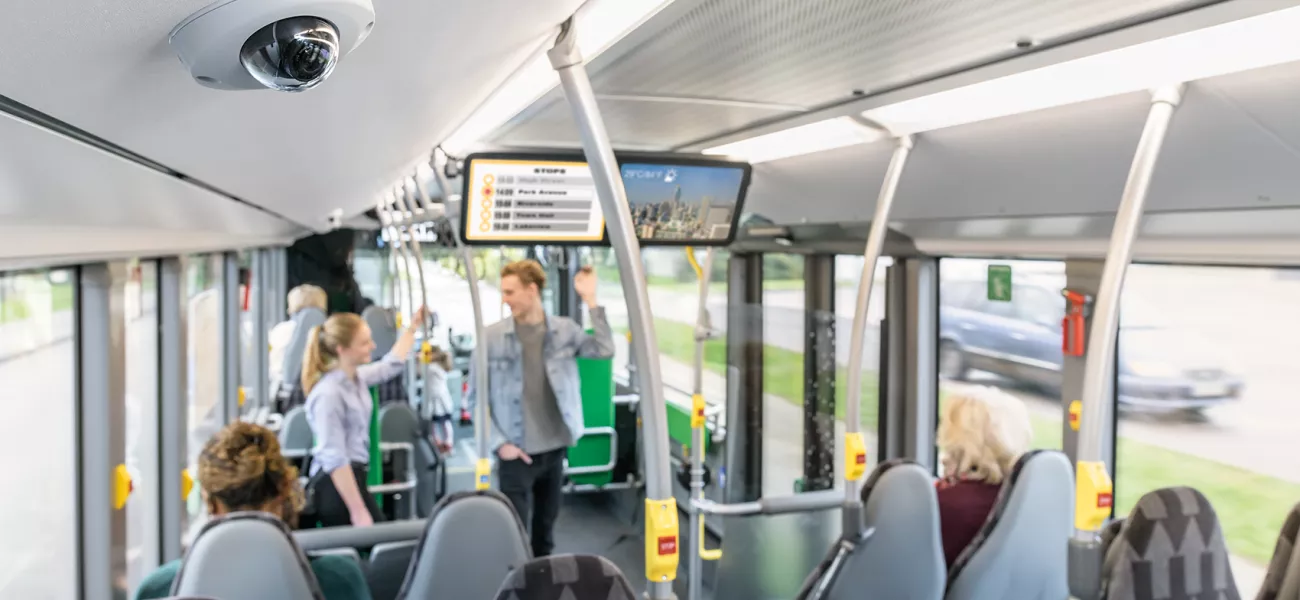
The transportation industry is slowly turning to digital network surveillance solutions. The next technological step is cloud-connected services, where cameras with edge computing drastically improve usability, scalability, and flexibility while reducing costs and environmental impact.
More and more industries reap the benefits of digitization and the Internet of Things (IoT) in meeting their video surveillance needs. However, the transportation industry has been slow to adapt to the latest technology.
“Here, it’s still the norm to have stand-alone cameras in buses that record onto video recorders. The data must manually be transferred to an external storage unit at the depot before someone can watch and analyze the footage using a PC. It’s a costly and time-consuming task,” says Lars Flodén, CEO of Swedish Observit.
This company has developed an easy-to-use, cloud-connected video surveillance and management solution, focusing on mobile transportation. Mainly for public transport buses and trains but also haulage vehicles.
Reduces the need for hardware

Observit’s mobile onboard surveillance solution uses intelligent Axis IP cameras with edge computing capabilities and wireless connectivity. The footage is recorded onto SD card storage inside the camera. It can then be sent on request to the cloud for storage and analysis.
The system is monitored and controlled centrally, so installing system updates or simultaneously getting footage from all buses in the fleet is not only possible but also easy. All it takes is two button pushes.
When the network camera acts both as a lens and computer and a server, much of the previously needed equipment of analog system architecture can be eliminated, including external servers and storage units and Wi-Fi points. In addition, it simplifies and reduces costs for system installation and maintenance. And you don’t need to replace worn-out or outdated hardware during the system lifespan.
Improves scalability and flexibility
Observit’s setup significantly improves the user’s day-to-day operation. Flodén points out that the ability to go from a traditional one-to-one system – where data must be retrieved and distributed manually – to one with one-to-many possibilities is a significant benefit.
“It increases the user-friendliness and reduces waiting time and costs when multiple stakeholders can access recorded video, audio, and metadata simultaneously and independently,” he says. “So, operators may find data for bus and fleet management and statistics, police and insurance companies can get footage that meets their specific needs.”
It is a flexible and scalable solution. Instead of investing heavily in hardware, bus companies can now invest in a service. This way, their video network systems are always updated and refined as new opportunities and new requirements are provided.
More functionalities with intelligent cameras
The Linux computer inside the Axis network cameras is the system’s heart. Therefore, you can easily add new programs and functionalities. Apart from the crucial network video surveillance, you can, for example, add people counting, vehicle damage investigation, bus lane enforcement, and vehicle position services. In addition, there is two-way audio, and various events and devices are possible, such as vehicle health checks and ignition interlocks.
Today, Observit primarily targets customers in the Nordic countries and the UK, selling directly or via partners. In total, there are currently more than 35,000 connected units.
“To reap the benefits,” Flodén says, “you only need Axis IP cameras and an account for subscribing to our service. There are no geographic boundaries, and we’re now running proof of concept tests on several continents.”
Substantial cost savings
Large bus companies and haulage contractors can benefit significantly from Observit’s services. The initial cost for purchasing the Axis cameras might seem higher than competing alternatives. However, the total cost of ownership (TCO) of the bus and equipment can be significantly lower if you consider the system life cycle, from installation to operation and maintenance.
Estimates indicate that the total cost savings might amount to 48 percent on hardware and software purchases for managing and storing the data and halved installation costs. Support and service costs can potentially shrink by 37 percent and operational expenses by two-thirds. In addition, without manually retrieving and handling data, the work hours will decrease.
“We recently did calculations for the most recent Axis cameras,” says Flodén, “and no matter how we counted, it was hard to get a TCO less than 40 percent lower than a traditional hardware-based system.”
Reducing the environmental impact
Also crucial, the cloud surveillance architecture reduces the environmental impact drastically, including an 88-percent reduction in carbon emissions, just by using less power in operation.
Using a cloud-connected solution provides the customer with massive advantages compared to an on-premises data center. Official figures from AWS (Amazon Web Services) state that the former will:
- have 77 percent fewer servers
- use 84 percent less power
- have a 28-percent cleaner power mix.
Many can benefit
Intelligent network cameras with edge-computing capabilities can also benefit existing and future Axis business partners targeting the transportation sector, says Björn Callenfors, Ecosystem Manager, Axis Communications.
“Digitization gains ground in this sector,” he says. “As a result, end-users are starting to ask, ‘why do we have a camera that is just a lens and can only send information to one source at a time?’ So, the demand for network-based and cloud-connected services will increase.”
When the camera acts as a computer, many innovative solutions to various everyday problems are possible. And it increases the value of Axis network cameras significantly.